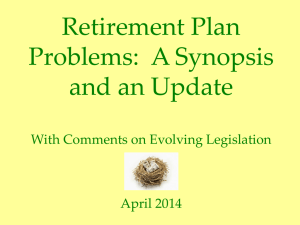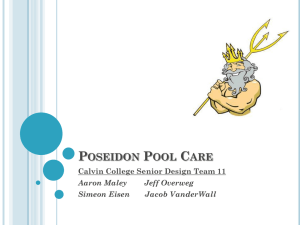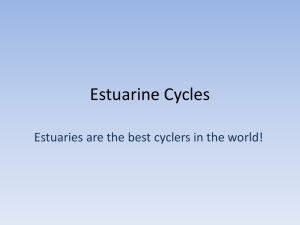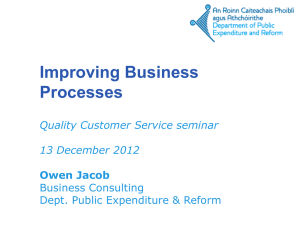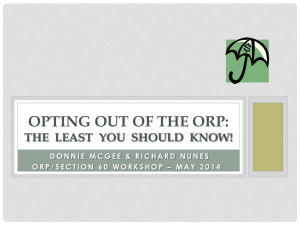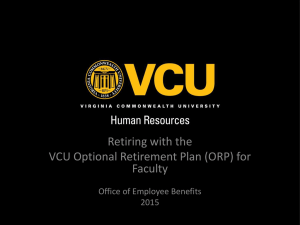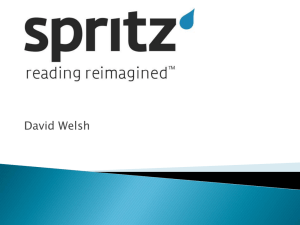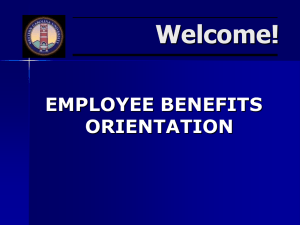Professor Robert Turner offering detailed charts and analyses of the
advertisement
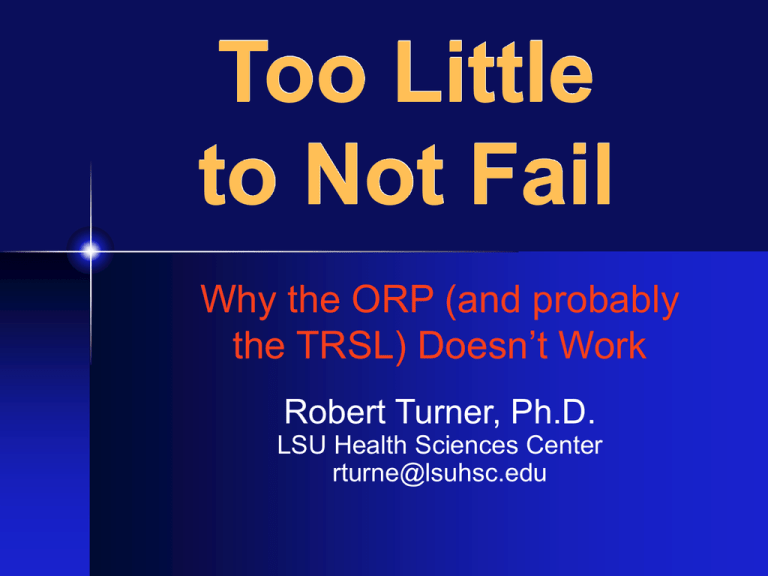
Too Little to Not Fail Why the ORP (and probably the TRSL) Doesn’t Work Robert Turner, Ph.D. LSU Health Sciences Center rturne@lsuhsc.edu Louisiana Retirement Plans The Teacher Retirement System of Louisiana (TRSL) is a defined benefits retirement program. As shown in the next figure, the benefit is based on a Benefit Factor (BF), length of service, and salary. It is not impacted by market performance. Faculty hired more than 10 years ago vest at 10 years and have a BF of 2.0% up to 20 years where it goes to 2.5% (age 65). Faculty hired less than 10 years ago vest at 5 years and have a BF of 2.5%. The Optional Retirement Plan (ORP) was created about 20 years ago and is a defined contribution plan. The employee and institution contribute to an investment account controlled by the individual. Vesting is immediate and the funds are portable. The retirement benefit is determined by the amount of money in the account. There is nothing fundamentally wrong with either type of plan if they are properly designed. Robert Turner Retirement Benefits PLAN VESTING BENEFIT (YoS/age) TRSL YoS: years % Factor x YoS x Salary Factor defined of service benefit % Factor: Salary Factor: new 5 yrs/60 21/2% Average of 3 old 10 yrs/60 2% < 20 YoS highest years (7/1999) 21/2% at 20 YoS of salary ORP defined contribution 1 day/NA What ever you have Robert Turner The Problem Many faculty on the ORP have realized that the potential retirement benefit provided by their ORP is a fraction of the benefit they would have received if they were on TRSL. Many have expressed the need to significantly delay retirement because of the sad state of their ORP accounts. What is the cause of this situation? There are several possibilities: •The individual faculty member has made poor investment decisions •The market has performed poorly •There is a fundamental problem with the ORP program This presentation will examine these possibilities and determine the primary factor Robert Turner Is the Problem Poor Investments? The next figure addresses the first possibility: Is the fundamental problem poor investments by the employee? This can be tested by asking how would ORP benefits compare to TRSL benefits if an ORP member’s investment return had been equal to TRSL or the S&P500 in the past? The TRSL website provides the average annual return in % (AAR) for TRSL investments for the past 17 years and the contribution (%) each year to ORP. The contribution is the percent of salary (employee + institution) that goes into the ORP account. A reasonable salary profile is assumed. The benefit is the income provided when the accumulated funds are used to purchase an annuity (6.8%) at age 60. The green bars indicate the annual dollar benefit provided by TRSL for the 2% and 2.5% benefit. When ORP performance equals TRSL (red bar), the benefit is about half compared to 2% and even less when compared to 2.5%. When ORP performance equals S&P500, benefit is even less. The benefit provided by ORP is far from comparable to TRSL. Poor investment performance is not the fundamental problem. Robert Turner Urban Myth: You Made Bad Investments compare Robert Turner Is the Poor Market the Problem? The following figure addresses this question: How would ORP benefits compare to TRSL benefits if market performance was “average and normal” and the ORP member’s return was consistent with the market. We can examine this question by assuming an average annual investment return equal to 8.25%/year. This is the percentage assumed by the TRSL actuaries for investment returns when calculating future revenue and liabilities. It is also about the AAR of the S&P 500 the past 20 years through 2009. The other assumptions are the same as the previous figure. With normal market performance, the ORP benefit (red bar) is better, but still significantly less that TRSL and only a little more than half of that provided by the 2.5% TRSL benefit (dark green). Obviously, poor market performance reduces ORP benefit, but it is not the fundamental problem. Robert Turner Don’t Blame a Poor Market Robert Turner What Does ORP Need? The next figure addresses this question: Since 8.25% isn’t enough, what investment average annual return (AAR) is needed so that ORP performance is comparable TRSL? The TRSL benefit (black line) was based on the 5yrs, 2.5% vesting requirement and the same salary profile used in previous figures. The ORP contribution (13.6%) for next fiscal year is used. ORP benefit was again calculated for investment AARs of 9%, 12%, 15%, and 20%, as indicated by the colored lines. To equal TRSL, you need an investment AAR greater than 20% at 10 yrs. Going back 40 years for the S&P 500, no ten year period has had an AAR greater than 20%. At 15 yrs, you need an AAR greater than 15%. Only eight times (20%) in the past 40 years has the 15 year AAR exceeded 15%. At 20 yrs, you need an AAR greater than 12%. Only 13 times (33%) in the past 40 years has the 20 year AAR exceeded 12%. At 25 and 30 years, you would need a smaller AAR; however, as one approaches retirement there is a need to be more conservative so earlier years would need to be a little greater. ORP needs an unrealistically high return to provide comparable benefits. Robert Turner Not Good Odds 12+% 13/40 20%/yr 15+% 8/40 15%/yr 12%/yr 20+% 0/40 Robert Turner 9%/yr Designed to Fail The previous figures have shown that the ORP is designed to “FAIL” because it does not provide benefits comparable to TRSL when 1. market performance is reasonable and typical. 2. Investment performance is reasonable relative to market performance. What is the problem? Is there a solution? Robert Turner How the Contribution is Calculated The next figure explains how the contributions to TRSL and ORP are determined. The top boxes show a 20 year average; the bottom boxes the amounts for next fiscal year. The employee contributes 8% of salary. The institutional contribution is divided into a smaller part called “Normal” and a larger part called “Unfunded Liability”. TRSL gets all three pieces for a 20 year average total of 23.6% of the employee’s salary. Only the employee contribution and the Normal part (6.7%) goes to the ORP account. This has averaged 14.6%. The Unfunded Liability (8.9%) piece paid by the institution for the ORP employee goes to TRSL. The ORP participant pays TRSL a 0.1% management fee. In FY 2010-2011, the percentage for TRSL is increased to 28.2%, the highest in history. For ORP, the percentage is decreased to 13.6%, the smallest in history. Robert Turner Contributions for Employees on TRSL vs ORP Plan 20 yr Average LSUHSC Normal LSUHSC Unfunded Total TRSL Total ORP TRSL 8.0% 6.7% 8.9% 23.6% 0.0% ORP 2010 2011 FY You 8.0% 6.7% 8.9% 9.0% +0.1% 14.6% TRSL 8.0% 5.7% 14.5% 28.2% 0.0% ORP 8.0% 5.7% 14.5+0.1% % 14.6% 13.6% Robert Turner History of TRSL and ORP The next figure shows the history of contributions to TRSL and ORP. In the 39 years prior to 1989, the contribution to TRSL averaged more than 16% of salary. From 1973 to 1988, the actuary recommended an increased contribution of about 21% but the contribution stayed under 18%. By the end of the 1980’s, TRSL had an unfunded liability of about $4 Billion. Some unfunded liability was due to TRSL taking over two other retirement programs, but much resulted from mandated increases in benefits provided by TRSL. In 1989, the TRLS contribution significantly increased and has averaged 23.6%. The ORP began in 1990 and has had an average contribution of 14.6%. It seems strange that a contribution of 14%-15% was specified for the ORP when decades of 16%-17% for the TRSL didn’t seem to be enough. Robert Turner ORP Was Born Why This much? Robert Turner A Little Conspiracy Theory When the ORP was created, the institutional contribution was divided into two parts: Normal and Unfunded Liability. TRSL has always received the Unfunded Liability contribution for all employees. Given the terminology and actions, what follows is a best-guess at the (not necessarily correct) rationale for the programs. This is illustrated in the next figure. The increased contribution (>20%) was more than enough to cover benefits provided by TRSL. In fact, the historic 16%-17% was more than was needed. Only 14%-15% was required by ORP and TRSL to cover benefits. The difference, the Unfunded Liability (9%) would be used to pay down the TRSL unfunded liability. Since there was no unfunded liability on ORP, that 9% could go to TRSL. Or, maybe, ORP was created to bail out TRSL. Entice TRSL members to transfer to ORP which eliminates future liability, and take most of the institutional contribution for ORP members. Robert Turner Born to Lose? Robert Turner Is 14+% Enough for TRSL? Is 14+% sufficient to provided adequate benefits? This is tested in the next figure. There are two measures of TRSL unfunded liability: UAL and UAAL. They give almost identical values. If 14+% was adequate to pay for benefits, then during periods of normal market performance, the 9% Unfunded Liability component could be used to pay down the UAL/UAAL. During the first half of the 1990’s, the S&P 500 returned 9%/year, a reasonable performance. During this time, the total contribution to TRSL was 24+%. One would expect a significant drop in UAL/UAAL. In fact, it remained constant indicating that 14+% was grossly inadequate and that the whole 24+% contribution was needed just to cover benefits and expenses. Only during the late 1990’s with the expanding tech bubble could the TRSL pay down UAL/UAAL. With the two subsequent “crashes”, the UAL/UAAL have spiraled up to about $10 Billion. Robert Turner No, 14+% Is Not Enough It took the full 24+% contribution just to cover benefits when market performance was “average”. 9%/yr 29%/yr No significant paydown in liability Robert Turner More Is Better Clearly, 14+% is not enough to support the benefits guaranteed by TRSL or to provide adequate benefits on ORP. What would have happened if ORP participants had received the full contribution provided to TRSL instead of the reduced 14+%. The next figure is the same as the first figure except that the contribution to ORP equals exactly that of TRSL (avg. 23.6%) the past 17 years. Market performance for ORP equals that for TRSL and the S&P 500. The ORP benefit is significantly better than with the actual 14+% ORP contribution, but still less than TRSL for the 2% and 2.5% benefit. Of course, actual market performance during these years was not good. Robert Turner With a Contribution Equal to TRSL (23.6%) compare Robert Turner To Small to Not Fail In the next figure, ORP benefit was calculated using the actual TRSL contribution (23.6% avg.) instead of the actual ORP contribution, and “normal” market performance of 8.25%/year. Under the conditions of normal market performance/reasonable investment return and increased contribution, ORP benefit was almost equal to the TRSL benefit. With a contribution of about 25%, the ORP benefit would be comparable to the TRSL benefit. The fundamental problem with the ORP is that the actual contribution is too small and virtually guarantees that the ORP will FAIL. Robert Turner With an Adequate Contribution, the ORP Does Not “FAIL” (23.6%) Robert Turner Other ORP Programs Many state universities have ORP-type retirement programs. The employee/institution contributions are shown in the next figure. Note that the LSU employee contribution is higher than most others and the institutional contribution is smaller. Still, the total contribution is about the same (14%-15%) for most states, with the exception of Ohio State which is significantly higher. If 14+% is too small of a contribution, then why is that the level for most universities? Robert Turner How Does Our ORP Compare to Other ORPs? Robert Turner One Minor Difference There is one important difference, as illustrated in the next figure. At all universities except LSU and Ohio State, the ORP program is designed to provided retirement income that supplements Social Security. They are not intended to be the only, complete, standalone retirement program. LSU and Ohio State do not participate in Social Security. Thus, these programs are complete, standalone programs. This explains why the Ohio Contribution to the ORP program is 20+%. Robert Turner Only a Piece of Retirement standalone supplemental Robert Turner The Magic Number is ~25% The next figure shows the total contribution to retirement programs. When Social Security is included, the total contribution is about 25%. A notable exception is LSU where the total contribution is slightly more than half the other universities and the State contribution is a fraction of the other states. These data support the conclusion that a contribution of about 25% is needed to turn the ORP into a viable stand-alone retirement program. Robert Turner Total Contribution Including Social Security Robert Turner Summary • The fundamental problem with the ORP is not poor investment decisions or a poor market; although both add to the problem. • The fundamental problem is a percent contribution that is much too small for the ORP to function as a “stand-alone” retirement plan. • Our ORP is designed to fail as a “stand-alone” retirement program in that the benefits will never be comparable to TRSL without unrealistically high investment returns. • Essentially, our ORP is a “supplemental” retirement plan that is presented as an alternative to TRSL which is a “stand-alone” plan. • A faculty member contributes the same amount (8%) to ORP as TRSL but receives much less in university contributions and retirement benefit. Robert Turner Summary • Both TRSL and ORP are “failing” because of underfunding. That is, the contribution percentage is too small. • In FY 2010-2011, the percentage for TRSL is increased to 28%, the highest in history. For ORP, the percentage is decreased to 13.6%, the smallest in history. The logic must be - the market has been poor, TRSL needs more money - the market has been poor, ORP needs less money • When TRSL fails, the burden is spread across all citizens of Louisiana. • When ORP fails, the burden falls on the individual faculty member. Robert Turner What Needs to be Done • If the ORP is going to be a “stand-alone” plan and a viable alternative to TRSL, it needs to be fixed by increasing the contribution to about 25% of salary. • The other option is to let it continue as a “supplemental” plan with the addition of another plan, e.g., Social Security. • For many current ORP participants, any fix to the ORP is toolittle, to-late. There should be a one-time opportunity to switch to TRSL. Robert Turner The End Robert Turner
